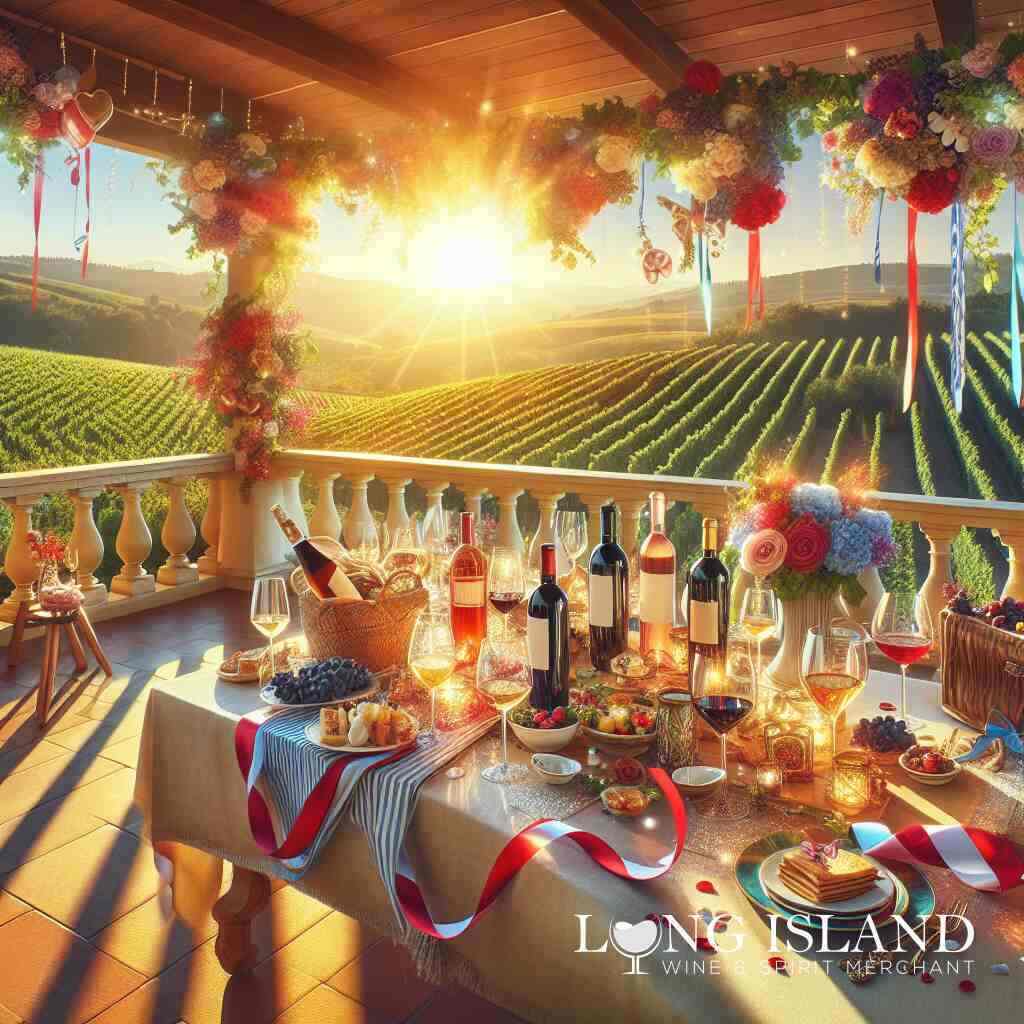
The Difference Between Dry and Sweet White Wine
August 28, 2024
Introduction to White Wine
Exploring the World of White Wine
White wine, a cornerstone of vineyards and dining tables around the world, offers a spectrum of flavors, aromas, and experiences that can transport wine enthusiasts from the rolling hills of Long Island to distant wine-producing regions across the globe. Its production, from the meticulous selection of grapes to the art of fermentation, results in a beverage that can punctuate life’s moments with joy and celebration. Whether it’s a crisp Chardonnay or a sweet Riesling, the world of white wine is rich with variety, each bottle holding stories of its origin, making, and the people behind its creation. As customers wander through the Long Island wines and spirits collection, they find themselves on a journey through the palette of the wine world.
The Importance of Understanding Wine Sweetness Scale
Understanding the sweetness scale is pivotal for both novice and experienced wine drinkers, essentially acting as a compass that guides one through the expansive sea of white wines. Sweetness in wine is determined by the level of residual sugar present after the fermentation process, influencing the overall taste and composition of the wine. It’s a fundamental aspect that affects pairing with food, suitability for occasions, and personal preference. Grasping the concept of the wine sweetness scale allows individuals to make more informed choices, aligning their selections with their taste preferences and culinary needs. By offering insights into this scale, Long Island Wine & Spirit Merchant aims to empower customers to select white wine on Long Island that perfectly matches their palate.
Overview of White Wine Varieties
White wine varieties are as diverse as the regions that produce them. Popular types like Chardonnay, Sauvignon Blanc, and Pinot Grigio each have unique flavor profiles, ranging from buttery and oak-infused to crisp and fruity. The climate and soil conditions, often referred to as terroir, play a significant role in these differences, giving each white wine its distinct character. From the full-bodied wines favored in cooler climates to the lighter, more acidic wines of warmer regions, understanding these varieties enriches one’s appreciation and enjoyment of white wine. With an extensive selection of white wine varieties in Long Island, Long Island Wine & Spirit Merchant offers an inviting platform for exploration and discovery, catering to every preference and occasion.
The Science of Sweetness in Wine
Sugar Content and Fermentation Process
Understanding the science behind the sweetness in wine begins with the sugar content and the fermentation process. Grapes, the primary fruit used in winemaking, contain natural sugars, which play a pivotal role in determining the final sweetness of the wine. The fermentation process, where yeast converts sugar into alcohol, is a delicate balance controlled by winemakers. Not all sugars are converted during fermentation, and the amount left unconverted significantly impacts the wine’s sweetness level. The wine-making process for beginners offers a glimpse into how intricate decisions regarding fermentation can sculpt the body, taste, and sweetness of the wine, presenting an intriguing blend of science and art.
Residual Sugar in Wine
Residual sugar, often abbreviated as RS, is the sugar remaining in the wine after fermentation has ceased, either naturally or by winemaker intervention. This residual sugar is what gives the wine its level of sweetness. The amount of residual sugar can vary significantly between wines, from the bone-dry varieties with nearly no detectable sugars to sweet dessert wines brimming with sweetness. It’s this variance in residual sugar that categorizes wines into different sweetness scales. Understanding the role of residual sugar not only helps in selecting white wine on Long Island but also in appreciating the winemaker’s craft in balancing sweetness to achieve a desired flavor profile.
How Winemakers Control Wine Sweetness
Winemakers employ several methods to control the sweetness of wine, making strategic decisions at various points in the fermenting process. Techniques include stopping fermentation early to retain more natural sugars, adding sulfites to preserve the desired sweetness level, or blending different batches of wine to achieve consistency and balance. Additionally, the choice of grape variety, harvest time, and the specific strains of yeast used for fermentation can influence the final sweetness of the wine. These decisions reflect a winemaker’s intent and style as they manipulate the elements to craft wines that range from dry to sweet, each with its unique character and appeal.
By understanding the science behind wine’s sweetness, enthusiasts can deepen their appreciation for this beloved beverage. Whether enjoying a glass of crisp, dry Sauvignon Blanc or savoring the lush sweetness of a Moscato, knowledge of these processes enriches the tasting experience, connecting the drinker to the vineyard, the winemaker, and the intricate dance of science and nature that brings each bottle to life.
Characterizing Dry vs Sweet White Wine
Defining Dry White Wine
Dry white wine is characterized by its low residual sugar content, often resulting in a crisp and refreshing taste that captures the palate with subtlety. Unlike their sweet counterparts, dry white wines go through a fermentation process that allows most of the natural sugars from the grapes to convert into alcohol, leaving behind minimal sweetness. From the sun-bathed vineyards on Long Island, renowned for their distinct terroirs, emerge some of the finest dry white wines- each bottle telling the story of its origin. Varieties such as Chardonnay, Sauvignon Blanc, and Pinot Grigio are celebrated for their dry profiles, offering a spectrum of flavors from mineral and citrusy to floral and herbaceous. These wines are particularly favored for pairing with food, as their acidity and complexity can enhance a wide range of dishes, from seafood to cheeses.
Characteristics of Sweet White Wine
Sweet white wine, on the other hand, is distinguished by its higher residual sugar content, which imparts a more prosperous and often fruitier flavor profile. These wines are produced through various winemaking techniques that halt fermentation prematurely or utilize grapes with naturally high sugar levels, such as those harvested late in the season. The essence of sweet white wine lies not only in its sweetness but also in its ability to balance acidity, aroma, and flavor, creating a harmonious and indulgent drinking experience. Varieties like Riesling, Moscato, and Gewürztraminer are widely appreciated for their luscious sweetness and aromatic depth, ranging from honey and tropical fruit to floral and spice notes. Sweet white wines can be enjoyed on their own, as a complement to dessert, or as a counterbalance to spicy and savory dishes, showcasing their versatility.
Reading Wine Labels to Determine Sweetness
Understanding wine labels is crucial for distinguishing between dry and sweet white wines. Labels provide valuable information about the wine’s origin, grape varietal, and, sometimes, its sweetness level. While not all labels explicitly state the wine’s sweetness, specific terms can offer clues. For example, terms like ‘dry,’ ‘off-dry,’ or ‘very dry’ indicate lower levels of residual sugar, whereas ‘sweet,’ ‘semi-sweet,’ or ‘dessert’ signify higher sugar content. Additionally, the alcohol content listed on the label can also hint at sweetness; lower alcohol percentages might suggest a sweeter wine, as less sugar has been converted to alcohol. Wine fans looking to expand their palates can benefit from wine-tasting events near Long Island, where they can explore a range of dry and sweet white wines, gaining first-hand experience in identifying and appreciating the nuances that each style brings to the table.

Popular Types of Dry and Sweet White Wine
Famous Dry White Wines from Long Island and Beyond
Long Island is a region that is revered for producing standout dry white wines that are celebrated across the globe. Among the most lauded varieties, Chardonnay takes a prime spot with its versatile character, ranging from crisp and mineral to rich and oaky. Sauvignon Blanc is another star known for its aromatic, crisp, and zesty nature. The elegance of these wines is a testament to the unique terroir of Long Island, where the maritime climate and well-drained soils contribute to the distinctive quality and flavor of these dry white wines. Wineries in Long Island continually push the boundaries of winemaking, experimenting with aging processes and fermentation techniques to refine the profiles of these beloved varietals. Venturing beyond Long Island, regions such as Burgundy in France and Marlborough in New Zealand are also celebrated for their exceptional dry white wines, showcasing the global tapestry of winemaking excellence.
Luscious Sweet White Wine Selections
Sweet white wines offer a delightful contrast to their dry counterparts, presenting wine enthusiasts with rich, complex, and often aromatic flavor profiles. The Riesling grape produces wines that range from lightly sweet and fruity to richly sweet with deep honey and apricot notes. Gewürztraminer, another sweet varietal, enchants with its lychee and rose petal aromas, encapsulating the essence of sweetness intertwined with aromatic complexity. Moscato, with its light and effervescent character, presents flavors of peach and orange blossom, making it a perfect choice for those new to the world of sweet white wines. These sweet selections, with their elevated sugar content and balanced acidity, are ideal for sipping alongside dessert or enjoying as a dessert in their own right. The legacy of sweet wine production flourishes in regions like the Mosel Valley in Germany and Alsace in France, where winemakers harness the natural sweetness of grapes to craft wines of extraordinary depth and sweetness.
Unique White Wine Grapes and Their Flavor Profiles
Exploring the unique white wine grapes and their flavor profiles opens up a new dimension of appreciation for the diversity within the world of white wines. Beyond the well-known varietals, lesser-known grapes exist that offer distinct and intriguing tasting experiences. Gruner Veltliner, primarily found in Austria, is celebrated for its peppery note alongside citrus and green apple flavors, offering a refreshing and zesty profile. Another interesting varietal is Viognier, which exudes rich aromas of peach, tangerine, and honeysuckle, providing a luscious and aromatic experience. Albariño, hailing from Spain, is known for its vibrant acidity and flavors of lemon, grapefruit, and nectarine. It is an excellent choice for those seeking a bright and refreshing white wine. Each unique grape varietal contributes to the rich tapestry of flavors and aromas found in white wines, showcasing the artistry and diversity of winemaking across different regions and climates. By exploring these unique grapes, enthusiasts can expand their palate and discover new favorites among the vast selection available at Long Island Wine & Spirit Merchant, where the exploration of white wine varieties in Long Island is made both accessible and satisfying White wine varieties in Long Island.
Wine Tasting and Education at Long Island Wine & Spirit Merchant
Join Wine Tasting Events to Explore White Wines
Long Island Wine & Spirit Merchant, situated in the scenic Northgate Shopping Center, is not just a premier destination for fine wine and good spirits but also a vibrant hub for wine enthusiasts looking to deepen their understanding and appreciation of white wines. Our wine-tasting events are tailored to both novices and connoisseurs, offering a unique opportunity to explore a diverse range of white wines, from the crisp and refreshing dry varieties to the lush and sweet options. Each event is designed to provide an immersive experience, allowing participants to savor the distinct flavors and aromas that characterize different white wines, learn about the nuances of winemaking and the wine fermenting process, and discover how regional variances impact the taste profile of each wine. These gatherings are not only educational but also social, inviting wine lovers to connect over shared interests and discoveries. For those interested in attending these enriching wine-tasting events near Long Island, Long Island Wine & Spirit Merchant regularly updates its schedule with upcoming occasions for all to partake in.
Wine Education: Learning the Nuances of White Wines
At Long Island Wine & Spirit Merchant, we firmly believe that knowledge enhances the wine-drinking experience. Hence, we offer comprehensive wine education sessions that delve into the art and science of winemaking, from vine to glass. These sessions cover critical topics such as the wine fermenting process, the impact of terroir on wine flavor, how to read and understand wine labels for sweetness, and the importance of serving temperatures. We explore the sugar content in wines and discuss the factors that contribute to the overall balance of a wine, including acidity, tannins, and alcohol content. Our wine education programs are an integral part of our mission to demystify the wine selection process and empower our customers to make informed choices that match their tastes and occasions. Whether you’re looking to understand the subtleties of wine aroma profiles or eager to learn how to pair wine with food, our knowledgeable staff is here to guide you through the beautiful world of white wines.
Utilizing the Wine Taste Quiz to Discover Your Preference
To further personalize the wine selection process, Long Island Wine & Spirit Merchant offers an innovative Wine Taste Quiz designed to pinpoint your taste preferences and recommend the perfect white wines to suit your palate. This interactive quiz takes you through a series of questions about your flavor preferences, drinking occasions, and favorite wine characteristics. Based on your responses, we curate a selection of white wines that align with your taste profile, ranging from dry to sweet, light-bodied to full-bodied, and from classic to unique varietals. This tailored approach ensures that every bottle you take home from our wine selection is a new favorite waiting to be discovered. Whether you’re exploring dry white wines for a formal dinner or searching for a sweet white wine for a cozy night in, the wine taste quiz near Long Island helps streamline your wine shopping experience, making it both enjoyable and educational.
Pairing and Serving White Wine
Food Pairing with Dry and Sweet White Wine
When it comes to pairing food with dry and sweet white wine, the balance of flavors is critical. Dry white wines, known for their crisp acidity and subtle fruitiness, complement dishes that are rich, creamy, or salty. A bright Sauvignon Blanc pairs wonderfully with fresh seafood or goat cheese, accentuating the meal’s freshness without overwhelming it with sweetness. On the other hand, sweet white wines like Riesling or Moscato offer a delightful contrast to spicy or tangy dishes. The sweetness of the wine can cool the heat of spicy Asian cuisine or enhance the flavors of a savory cheese platter. Understanding the nuances of pairing food with dry and sweet white wine enhances the dining experience, creating a harmonious blend of flavors that elevates both the dish and the wine.
Ideal Serving Temperature for White Wines
The temperature at which white wine is served significantly impacts its taste and aroma. As a general rule, dry white wines should be served chilled, between 45°F and 50°F, to preserve their crispness and refreshing qualities. This temperature range accentuates the wine’s acidity and fruitiness, making it more enjoyable. Sweet white wines, however, can be served slightly warmer, between 50°F and 55°F, allowing their complex flavors and sweetness to emerge fully. Serving white wine at the ideal temperature enhances its character, making each sip a more engaging experience. Investing in a wine refrigerator or a decent wine thermometer can aid in achieving these optimal serving conditions, ensuring that the wine’s integral qualities are preserved and appreciated.
Enhancing Your Wine Experience with Proper Glassware
The choice of glassware plays a crucial role in the white wine-tasting experience. White wine glasses are typically smaller than red wine glasses, with a narrower bowl that directs the wine to the front of the mouth, allowing the drinker to appreciate the wine’s acidity and balanced sweetness fully. For dry white wines, a glass with a slightly tapered rim is ideal, as it focuses the wine’s aroma towards the nose, enhancing the wine’s complexity and crisp, clean finish. Sweet white wines benefit from a glass with a broader bowl, which allows the aromas to concentrate and intensify, enriching the overall tasting experience. Proper glassware not only complements the wine but also serves as an extension of the tasting journey, guiding the aromas and flavors in a way that maximizes enjoyment. Investing in quality wine glassware designed for specific white wine varieties can transform a simple glass of wine into an extraordinary sensory exploration.

Conclusion: Enhancing Your White Wine Journey
Summarizing the Delicate Balance Between Dry and Sweet White Wine
The journey through the world of white wines highlights a landscape rich in diversity, complexity, and sheer delight. From the crisp, refreshing allure of dry white wines to the lush, fragrant realms of sweet white varietals, each bottle offers a unique story and an invitation to explore flavors that resonate with individual palates. Understanding the delicate balance between dry and sweet white wines is critical to appreciating the artistry behind winemaking. It allows for a deeper connection with the craft, opening up new avenues for enjoyment and exploration. The intricate dance between sugar content, fermentation processes, and the winemaker’s vision manifests in the diverse array of white wines available, each with its character and charm.
How To Further Explore White Wine with Long Island Wine & Spirit Merchant
Long Island Wine & Spirit Merchant is your companion on this enriching journey. With a commitment to educating wine enthusiasts and novices alike, we offer an array of services designed to deepen your understanding and appreciation of white wine. From wine-tasting events intended to explore the spectrum of flavors across dry and sweet white wines to personalized wine education sessions that delve into the nuances of winemaking, our experts are here to guide you. Our Wine Taste Quiz is a tailored approach to discovering wines that match your preferences, ensuring every selection from our vast assortment is a delightful discovery. Whether you’re refining an existing palate or embarking on a new wine adventure, Long Island Wine & Spirit Merchant is your gateway to the exquisite world of white wines.
Invitation to Explore Our Wine Selection and Services
We extend a warm invitation to explore our carefully curated selection of fine wines and spirits. At Long Island Wine & Spirit Merchant, our shelves are lined with a diverse range of white wines, selected for their quality, character, and the stories they tell the vineyards of Long Island to celebrated wine-producing regions around the world. Our goal is to make the exploration of wine accessible, enjoyable, and enlightening. Whether through ordering alcohol online for convenient delivery or visiting us for a wine-tasting experience, we’re here to enhance your wine journey. We invite you to discover new favorites, learn more about the fascinating world of wine, and find the perfect bottle to share with friends and loved ones. Let’s raise a glass to the endless possibilities and the shared joy of white wine.
Embrace your passion for white wine with Long Island Wine & Spirit Merchant, where every bottle tells a story, and every sip is a step further on your wine journey. Visit us today and let us help you navigate through the splendid variety of dry and sweet white wines, each waiting to be unveiled and cherished.
Frequently Asked Questions
Question: What factors determine the sweetness in white wines, and how does Long Island Wine & Spirit Merchant help customers understand the wine sweetness scale?
Answer: The sweetness in white wines is primarily determined by the sugar content and the wine fermenting process. At Long Island Wine & Spirit Merchant, we prioritize educating our customers on the wine sweetness scale by providing detailed descriptions and wine-tasting notes for each bottle in our selection. Our knowledgeable staff is always ready to assist in selecting white wine that aligns with your taste preferences, whether you’re interested in dry white wine or sweet white wine. We also host wine-tasting events focused on understanding the balance of wine sweetness chart, sugar levels, and wine acidity, making it easier for our customers to find wines that match their palate.
Question: Can you explain the role of residual sugar in wine and how it influences the characteristics of dry and sweet white wine?
Answer: Residual sugar in wine is the sugar left over after the fermentation process has ended. It’s a critical factor in determining whether a wine tastes dry or sweet. At Long Island Wine & Spirit Merchant, we recognize the importance of residual sugar levels in shaping the wine’s flavor profile and overall taste experience. Dry white wines typically have lower residual sugar content, offering a more crisp and refreshing flavor. In comparison, sweet white wines have higher residual sugar content, resulting in a rich and often fruity or floral taste. By providing wine-tasting notes and educational resources, we guide our customers in understanding how residual sugar in wine impacts their choice, ensuring they select a wine that delights their palate.
Question: How does Long Island Wine & Spirit Merchant curate their selection of white wine varieties, mainly focusing on dry and sweet types?
Answer: At Long Island Wine & Spirit Merchant, our selection of white wine varieties is meticulously curated to cater to a vast array of preferences and occasions. We explore both local Long Island wines and international offerings, assessing them based on quality, flavor profiles, wine acidity levels, and, importantly, the balance between dry and sweet characteristics. Our sommeliers and wine experts are continually sampling new wines, using their understanding of the wine-making process and the wine sweetness scale to choose wines that meet our high standards. By incorporating customer feedback and staying informed about wine trends, we ensure our wine rack is stocked with the best selections, from dry Sauvignon Blancs to luscious Moscatos. This makes us a go-to destination for fine wine and good spirits.
Question: In the blog titled “The Difference Between Dry and Sweet White Wine,” how does Long Island Wine & Spirit Merchant recommend pairing these wines with food?
Answer: The blog “The Difference Between Dry and Sweet White Wine” emphasizes the value of pairing the correct type of white wine with specific dishes to enhance both the wine and the food’s flavors. At Long Island Wine & Spirit Merchant, we recommend pairing dry white wines, such as Chardonnay or Sauvignon Blanc, with lighter dishes like seafood or salads to complement their crisp acidity. Sweet white wines like Riesling or Moscato are excellent with spicier foods or desserts, as their sweetness can balance the heat and enrich the meal’s taste. Our staff is well-versed in wine and food pairings, offering personalized recommendations that elevate any dining experience. We also host wine-tasting events where patrons can learn directly about pairing options, ensuring they have the knowledge to make informed choices about food pairing with dry and sweet white wine.
Question: How does Long Island Wine & Spirit Merchant assist customers in navigating through different white wine grapes and their unique flavor profiles?
Answer: At Long Island Wine & Spirit Merchant, we believe in making the exploration of different white wine grapes and their unique flavor profiles an accessible and educational experience. Our staff includes seasoned wine educators who offer insights into the distinct characteristics of various white wine grapes, from popular varieties like Chardonnay and Riesling to lesser-known gems like Viognier and Albariño. In-store, customers can find detailed tasting notes and signs that explain each wine’s character, origins, and recommended pairings. Additionally, we conduct wine-tasting events and education sessions focused on exploring the diversity of white wine grapes, guiding customers through tasting, and appreciating the nuances that each variety presents. Through these efforts, we aim to empower our customers with the knowledge to confidently select wines that resonate with their tastes and enhance their wine-drinking experiences.
Question: How important is serving temperature for white wines, and does Long Island Wine & Spirit Merchant offer advice on this aspect?
Answer: Serving temperature is crucial for maximizing the enjoyment of white wines, as it significantly affects the wine’s flavor and aroma. At Long Island Wine & Spirit Merchant, we provide expert advice on the ideal serving temperatures for different types of white wines to ensure our customers can experience each wine at its best. For dry white wines, we recommend chilling them between 45°F and 50°F to highlight their crispness and acidity. Sweet white wines, on the other hand, are best served slightly warmer, at around 50°F to 55°F, to appreciate their nuanced flavors and sweetness better. Our staff is always ready to offer tips and best practices for serving and enjoying white wine, including the use of proper glassware and techniques for chilling wine to achieve the perfect temperature.



